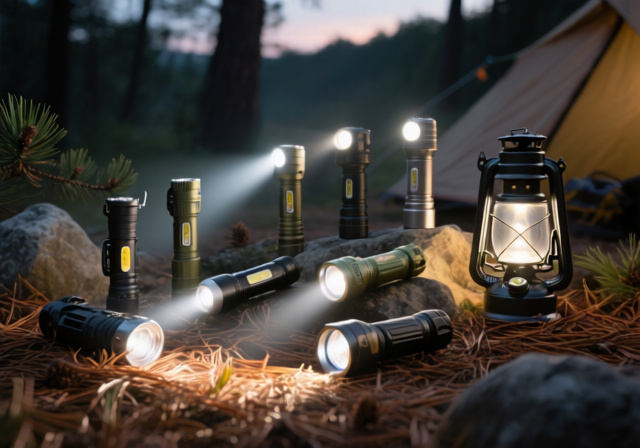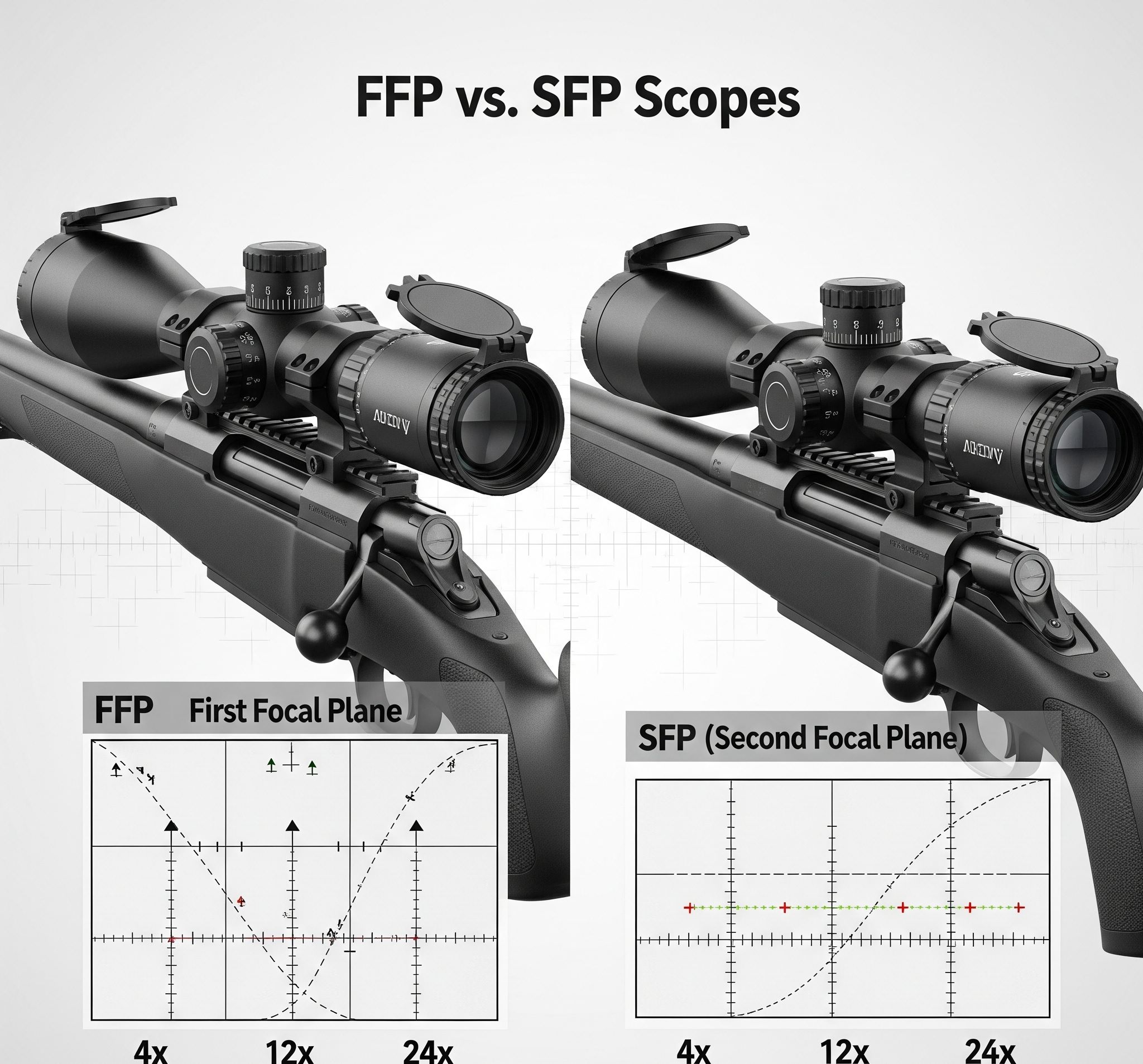



Choosing between first focal plane (FFP) and second focal plane (SFP) scopes remains one of the most debated topics among shooters in 2025. Whether you’re a precision rifle competitor, long-range hunter, or tactical shooter, understanding the fundamental differences between FFP and SFP optics can dramatically impact your shooting experience and accuracy. This comprehensive guide breaks down everything you need to know about focal plane placement to make an informed decision.
The focal plane debate centers on where the reticle sits within your scope’s optical system. In first focal plane scopes, the reticle is positioned in front of the magnification assembly, causing it to grow and shrink with magnification changes. Second focal plane scopes place the reticle behind the magnification system, keeping it the same visual size regardless of zoom level.
This seemingly simple difference creates profound implications for how you’ll use your scope in real-world shooting scenarios. FFP optics maintain consistent subtension values across all magnifications – a 1 MIL mark always equals 1 MIL whether you’re at 4x or 24x power. SFP scopes typically calibrate their reticle measurements to work accurately at maximum magnification only.
In 2025, the rifle scope market has evolved significantly, with FFP options becoming more affordable and SFP designs incorporating advanced features previously reserved for premium models. Understanding these focal plane differences helps you match your optic choice to your specific shooting discipline and budget.
FFP scopes excel in dynamic shooting environments where you need to engage targets at varying distances without time to adjust magnification. The reticle’s proportional scaling means your holdover points, windage marks, and ranging calculations remain accurate at any power setting. This consistency proves invaluable for competitive precision rifle shooters who must quickly transition between near and far targets.
Long-range hunters increasingly choose FFP optics for their versatility in field conditions. When that trophy elk appears at 600 yards but mirage forces you to dial back from 20x to 12x magnification, your ballistic holdovers remain perfectly calibrated. The ability to make accurate shots without worrying about magnification settings provides crucial confidence during critical moments.
However, FFP scopes present challenges at lower magnifications. The reticle can appear thin and difficult to see at minimum power, potentially problematic for close-range shots in low light. Many manufacturers address this with illuminated center dots or bold outer posts, but it remains a consideration for hunters who frequently encounter both close brush shots and long-range opportunities.
The Vortex Diamondback Tactical FFP represents exceptional value in today’s market. Based on recent testing data, this scope delivers performance well above its $399 price point. Users consistently praise its clear glass, positive turret clicks, and accurate tracking through extensive shooting sessions.
SFP scopes dominate the hunting market for good reasons. The consistent reticle size provides excellent visibility across all magnification levels, crucial for quick target acquisition in varying light conditions. When that buck steps out at last light, you’ll appreciate a bold, easy-to-see reticle regardless of your magnification setting.
Traditional hunters often prefer SFP designs because most hunting shots occur within reasonable distances where complex reticle subtensions aren’t necessary. The simpler visual presentation reduces confusion and speeds up the aiming process. For shots under 400 yards – which encompasses the vast majority of hunting scenarios – SFP scopes offer all the capability most hunters need.
The main limitation appears when using holdover marks or reticle-based ranging at different magnifications. SFP scope users must remember that their reticle subtensions only work correctly at one specific power setting, typically maximum magnification. This requires either always shooting at full power when using holdovers or doing mental math to compensate for different magnification levels.
Leupold’s VX-Freedom exemplifies why SFP scopes remain popular among serious hunters. The 50mm objective lens gathers impressive light for those critical dawn and dusk periods when game moves most actively. At $349.99, it delivers American-made quality with Leupold’s legendary reliability.
Competitive precision rifle shooters overwhelmingly choose FFP scopes. The ability to use reticle holds at any magnification proves essential when engaging multiple targets at varying distances under time pressure. In 2025, nearly all top PRS competitors use FFP optics, with features like zero stops and precise tracking taking priority over low-light performance.
The hunting community remains divided on focal plane preference. Western hunters pursuing game at extended ranges increasingly favor FFP scopes for their ranging and holdover capabilities. Eastern whitetail hunters typically stick with SFP designs, valuing the consistent reticle visibility for shots in dense cover where magnification flexibility matters less than quick target acquisition.
Military and law enforcement applications show interesting focal plane preferences. While military snipers often use FFP scopes for their versatility in unknown-distance engagements, many law enforcement marksmen prefer SFP designs. The consistent reticle size helps with rapid deployment in urban environments where shot distances rarely exceed 100 yards.
Manufacturing FFP scopes requires more precise engineering than SFP designs. The reticle must be etched or placed on a lens element within the erector assembly, demanding tighter tolerances and more complex construction. This typically translates to higher costs, though advancing manufacturing techniques have narrowed the price gap considerably in recent years.
Durability differences between focal plane types have largely disappeared with modern construction methods. Both FFP and SFP scopes from reputable manufacturers withstand significant recoil and environmental abuse. The old concern about FFP scopes being more fragile no longer applies to quality modern optics.
Light transmission can vary slightly between designs, with some SFP scopes offering marginally brighter images due to simpler optical paths. However, modern lens coatings and glass quality improvements have minimized these differences to the point where they’re rarely noticeable in field conditions.
In 2025, the price differential between comparable FFP and SFP scopes has decreased significantly. Entry-level FFP options now start around $300-400, while similar-quality SFP scopes range from $200-350. The narrowing price gap makes FFP technology accessible to more shooters than ever before.
Premium FFP scopes still command higher prices than their SFP counterparts. A top-tier FFP scope might cost $2,000-3,000, while a comparable SFP model runs $1,500-2,500. The additional cost reflects the precision required in FFP reticle placement and the typically more complex reticle designs found in these scopes.
Regardless of focal plane choice, proper scope installation remains critical for optimal performance. Both FFP and SFP scopes require careful ring alignment and appropriate torque specifications. The mounting process doesn’t differ between focal plane types, but FFP scopes may benefit from slightly higher mounting positions to maximize the field of view at lower magnifications where the reticle appears smallest.
Zeroing procedures remain identical between FFP and SFP scopes. However, FFP users should verify their zero at multiple magnification levels to ensure the reticle tracks properly through the zoom range. Quality FFP scopes maintain zero regardless of magnification, but verification provides confidence in your equipment.
The optics industry continues innovating to address traditional focal plane limitations. In 2025, we’re seeing hybrid reticle designs that combine the benefits of both systems. Some manufacturers offer dual-focal-plane scopes with elements in both positions, though these remain expensive specialty items.
Digital scopes may eventually eliminate the focal plane debate entirely. These electronic optics can display reticles that behave according to user preference, switching between FFP and SFP characteristics on demand. While current digital scopes face battery life and durability challenges, advancing technology suggests they’ll become viable alternatives within the next few years.
Yes, but the holdover values only remain accurate at the magnification where the reticle is calibrated (usually maximum power). At half magnification, your holdover values double, requiring mental calculations for accurate shots.
FFP construction requires placing the reticle within the erector system, demanding tighter manufacturing tolerances. The reticles themselves are often more complex, with finer details that must scale properly through the magnification range.
Modern military forces increasingly use FFP scopes for their versatility in unknown-distance engagements. However, some units still employ SFP scopes, particularly for specific missions where consistent reticle visibility takes priority.
Most dangerous game hunters prefer SFP scopes for their bold, easy-to-see reticles at all magnifications. Quick target acquisition often matters more than precise holdovers when facing charging buffalo or bears at close range.
The FFP vs SFP debate doesn’t have a universal answer because different shooting disciplines demand different tools. In 2025, both focal plane designs have evolved to serve their intended purposes exceptionally well. FFP scopes dominate long-range precision shooting for good reasons, while SFP designs continue excelling in traditional hunting roles.
Your shooting style, typical engagement distances, and budget should guide your focal plane decision. Don’t feel pressured to choose FFP simply because it’s trendy – many accomplished shooters still prefer SFP scopes for their specific applications. Conversely, don’t dismiss FFP technology if your shooting would benefit from its unique advantages. The best scope is the one that helps you consistently hit your target under your real-world conditions.







